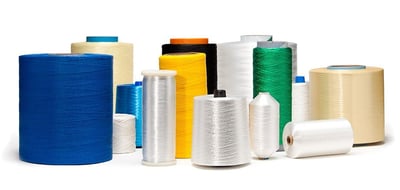 Twist can impact the dynamics of your final product in many ways – strength, elongation, diameter, torque, lustre, softness etc. Unlike staple spun yarns, multifilament yarns lose strength as the twist is increased, therefore it is important to know the physical requirements required in the end product. Elongation increases with increasing twist, as does diameter, torque and lustre. Yarns become stiffer with twist therefore softness decreases.
Twist can impact the dynamics of your final product in many ways – strength, elongation, diameter, torque, lustre, softness etc. Unlike staple spun yarns, multifilament yarns lose strength as the twist is increased, therefore it is important to know the physical requirements required in the end product. Elongation increases with increasing twist, as does diameter, torque and lustre. Yarns become stiffer with twist therefore softness decreases.
The twist level can be measured in Turns per inch (TPI) or Turns per meter(TPM). In order to maintain the same surface twist angle and similar yarn/thread characteristics for all sizes of sewing thread, Twist Multipliers (TM) are used to establish the level of TPM or TPI required. If one wishes to know the TM being used, this can be obtained by multiplying the twist level by the square root of the linear density of the yarn e.g. TM = TPM x Square Root of Linear Density in Tex/1000.
To know what twist a yarn has in it, this information can be found in the yarn specification or can sometimes be found in the item description. An example of a description would be 1000DN Z060, this means the yarn has 60 TPM in the Z direction. Below shows how TPM relates to TPI
40 TPM = 1 TPI
Z060 TPM = 1.5 TPI Z
Filament yarns, depending on denier, can have a filament count ranging 70 to 300 and adding a twist can help keep these strands together, however too much can damage the yarn and/or cause it to be too lively by having too much torque. See our blog on excessive twist cures to see what can be done to reduce torque in yarns with high twist levels.
The more twist a yarn has, the more cost is involved, so depending on what you are trying to achieve through sewing or yarn processing, the proper twist is critical.
To ensure optimum sewing performance, the correct twist levels must be applied to a sewing thread construction. Sewing threads having a round cross-section tend to sew better than those with a flatter cross-section. Monocords having no twist will perform poorly, some twist is recommended. Bonded Multifilament cabled sewing threads are ideal for industrial sewing but sometimes twist in one end of yarn is enough to sew certain types of material.
For process related applications like hose manufacturing a common twist is Z060 in many of the fibers that are used however certain hose constructions require different twist. The twist affects how yarn is processed in a hose because yarn having lower twist, say 1.5 tpi, will have a flatter footprint than yarn with a higher twist, say 4.0 tpi. Higher twist and hence rounder tighter cross-section, will allow more strike through of the rubber or pvc hose material. Burst strength may also be influenced by twist levels – higher twist, which causes lower breaking strength, may lead to lower burst strengths.
Another common process application is braider yarns in wire and cable. Sometimes twist is not desired in wire and cable applications because there is more coverage from the yarn when it is flat. You may want twist in your yarn for wire and cable to reduce frictional properties between materials by allowing a “rolling action” on surfaces. Twist in yarn will also offer supply packages with higher density and higher integrity which will allow them to withstand higher centrifugal forces during certain braiding and wrapping operations – allow higher hose and cable production rates.
Do you need help determining the right twist level for the yarns used in your application?



